| 1 | Brazilian false coral snake |
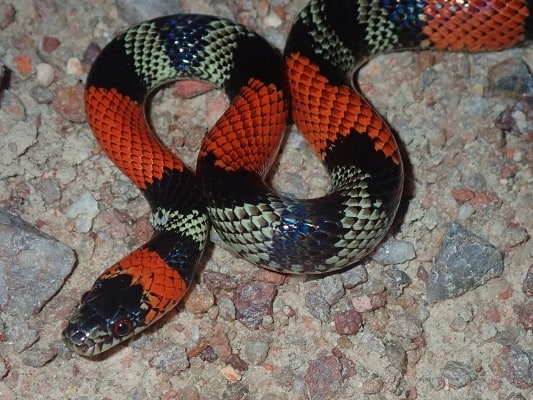
A common coral snake mimic in eastern Brazil, which has thrived by fooling predators into thinking it’s severely venomous. In reality, Oxyrhopus trigeminus lacks any serious venom, and defends itself by producing a vile snake smell. This species is common near Rio de Janeiro and the capital Brasilia, and also inhabits Bolivia and Paraguay. They measures 40-60cm, and their habitats include open cerrado and sandy restinga forests alike. This is a nocturnal snake, which sticks to the ground, rarely climbing trees.
Eastern Brazil has several coral snake species, but the closest match for Oxyrhopus trigeminus is the ribbon coral snake (Micrurus lemniscatus). Both have wider red bands, followed by three thinner black bands and a white band inbetween. A strong difference is that the false coral snake has large, protuberant eyes, which have a red iris – the ribbon coral snake’s eyes are tiny (see here).
Another reason this mimic is so common is that while mammals dominate their diet, they’re a very flexible eater. A study from southeast Brazil found a diet of 46.7% rodents, 33.3% lizards and 20% birds. They’re also confirmed to prey on snakes, specifically the brown vine snake.
| 2 | False tree coral |
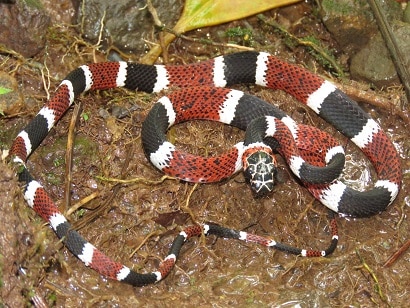
A coral snake mimic of Central America, particularly Costa Rica. Rhinobothryum bovallii lives alongside several deadly species, including the Central American coral snake (Micrurus nigrocinctus) and Allen’s coral snake.
This coral mimic is mainly found at low altitudes, usually below 1000 metres, and very rarely above 1500 metres. Like its coral snake neighbours, they favour untouched primary forests, particularly lowland tropical forest and premontane forest. The more fragmented a forest becomes by agriculture, the more Rhinobothryum bovallii will disappear. There are no gotcha ID signs, but the best one is probably its head, which has a cracked black pattern with snowy white showing underneath. Costa Ricans colloquially dub this snake “Cabeza de Tortuga” (turtle head) because of these cracked patterns.
This is a relatively large coral snake mimic. At one stage, the record length was 130.2cm, until in 1997, when a 176.2cm individual captured in Limón Province, Costa Rica demolished this completely. This also shows how sketchy the research for this species is. While its effects on humans are a mystery, Rhinobothryum bovallii possesses a venom of its own, which is strongly targeted towards green iguanas, paralysing them irreversibly, while barely affecting small mammals.
This species has a strong geographical dividing line, as they’re found only west of the Andes, in Colombia and Ecuador, before moving into the central American nations of Panama, Costa Rica, and Nicaragua. False tree corals are one of just two Rhinobothryum members, the other being the Amazon banded snake, which lives exclusively east of the Andes (including in Brazil).
| 3 | São Paulo false coral snake |
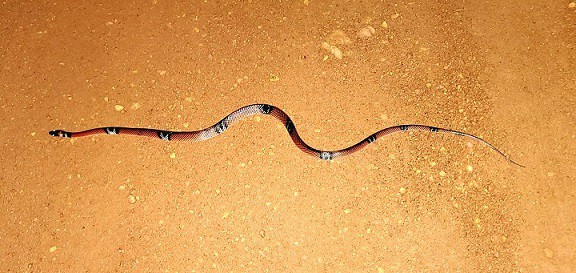
A relatively small coral snake mimic, ranging from 25-78cm. Simophis rhinostoma mainly lives in southeast Brazil, along the Atlantic coast, as well as eastern Paraguay. They avoid thick forests, and prefer open cerrado savannahs and grasslands, plus secondary forests degraded by mankind. Species this mimic coexists with include the painted coral snake (Micrurus corallinus) and decorated coral snake, and the wide red spacing followed by tightly bunched black-white has a close resemblance to both.
This species is no threat to humans. Simophis rhinostoma has short, feeble teeth, and while they bite if picked up, they’re incapable of causing serious damage. When cornered, this coral snake mimic has various strategies: fleeing, freezing, thrashing, raising their tail menacingly, flattening their body, an S-coil, false strikes, actual strikes and biting. They have a huge repertoire of defensive tricks – all except venom itself.
One study examined 12 Simophis rhinostoma gathered in the state of São Paulo, Brazil. 5 had identifiable prey in their stomachs, and all were frogs, the top species being Cuvier’s weeping frog. Insect remains were also found. There were no rodents or lizards.
| 4 | Broadhead ground snake |
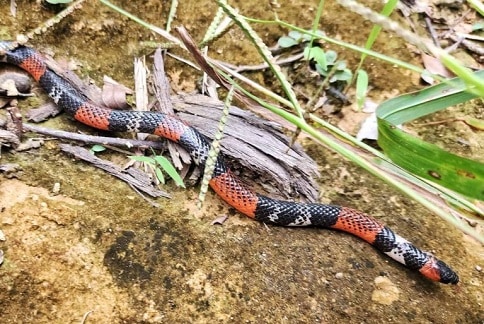
This coral snake mimic is found across a huge swathe of central and northwest Brazil, crossing into Peru and Bolivia as well. They’re a forest snake through and through, appearing in primary lowland rainforest and riverside gallery forests, occasionally straying to roads inbetween, or slithering around recently deforested areas in horror. Despite such a huge range, Atractus latifrons is encountered by humans only rarely.
Broadhead ground snakes have various names, including wedgetail earth snake and broadhead arrow earthsnake. This species has various morphs, each mimicking a certain coral snake species. The first is bicolored, featuring black overlaid with thin white stripes (picture). According to a 2022 study, this likely evolved to mimic the white-banded coral snake (Micrurus albicinctus). Meanwhile, the tricolored morph above probably evolved to mimic the ribbon coral snake (Micrurus lemniscatus). Then there’s a third morph with extremely wide red bands (see here), which is mimicking Avery’s coral snake.
Atractus latifrons mainly sticks to the floors of forests, burrowing itself into soft soils. It feeds on insects and earthworms, and averages at 50-60cm.
| 5 | Aesculapian false coral snake |
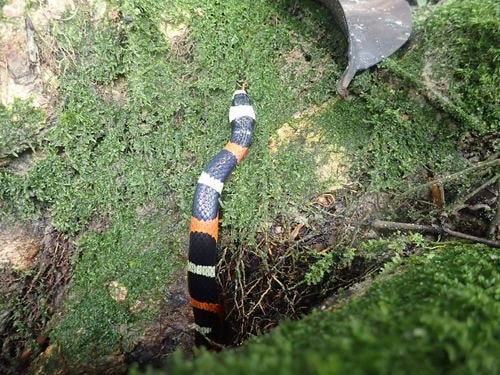
A member of the huge Erythrolamprus family, which currently has 55 members. This species averages at 65-80cm, and has a giant range, covering almost the entirety of Brazil, as well as Peru, Bolivia and northern Argentina. Erythrolamprus aesculapii has a mixture of red, white and black scales, but varies constantly in the exact placement, depending on which coral snake it needs to mimic. This is a forest species which is normally spotted by people on forest trails, or occasionally roads adjacent to forests. Their diet includes fellow snakes, like the grey ground snake (Atractus occipitoalbus) and Panama spotted night snake.
Unlike many mimics, this species has its own dangerous venom, which isn’t to be underestimated. This is a rear-ranged (opisthoglyphous) snake, which is forced to chew venom into its prey manually. According to hospital data from Butantan, Brazil, 1965 bites from rear-fanged snakes were recorded from 1959 to 1999. The Aesculapian false coral snake accounted for 10 cases, or 0.5%.
In 2016, a 24 year old man suffered a bite from an Aesculapian false coral snake measuring 69cm. After 5 minutes, his finger began swelling painfully, and after 1 hour, his entire hand was swollen, with the bite mark bleeding heavily. After another four hours, a painful blister appeared and the swelling reached the elbow. The next day saw his entire arm swell up, and another agonising blister form. That said, this victim was chewed on the finger for a full minute before he removed the snake.
| 6 | Variegated false coral snake |
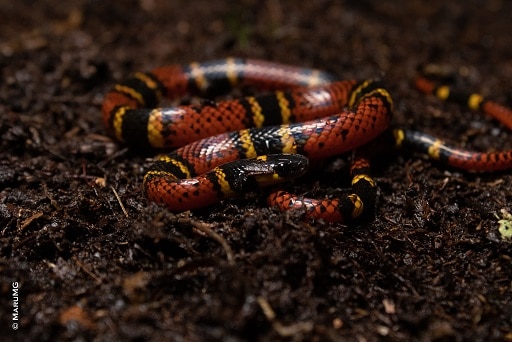
A central American coral snake mimic, which begins in Costa Rica, and continues all the way to northeast Mexico, not quite reaching the US border. This mimic coexists with several real coral snakes, including the Texas coral snake, Brown’s coral snake, and variable coral snake.
Pliocercus elapoides reaches a maximum of 180cm, and is variable in colour, though not quite as variable as the broadhead ground snake. This species isn’t found in open grassland, but a variety of forest types, from wet forests to dry forests to cloud forests, and also coffee plantations. While not heavily researched, most sightings of prey so far have been salamanders, including the coffee grove salamander (Aquiloeurycea cafetalera).
This snake has round eyes and smooth scales to touch, with a head distinct from the neck. The variegated false coral snake may have the nastiest venom of this list. In 1979, a 23 year old herpetologist was gripping this snake for an injection, where it suddenly snapped down onto his finger. The bite lasted less than a second, yet just 3 minute later, the entire finger was swollen, and 10 minutes later, the entire hand was swollen. The solution: run if you see red-yellow-black colours in Mexico, as it’ll save you in either scenario.
| 7 | False coral snake – E. bizona |
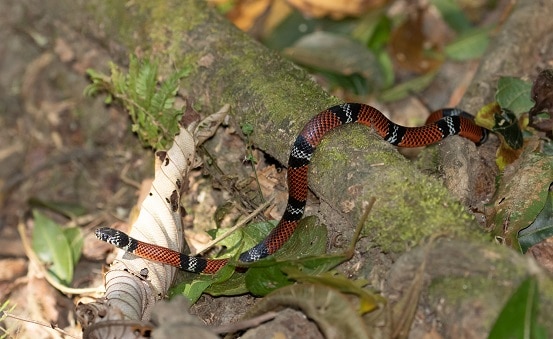
A coral snake mimic of Costa Rica, Panama and Colombia. Erythrolamprus bizona mainly inhabits evergreen and semi-deciduous forests, and they’re relatively common throughout their territory. With white, black and red bands covered with dark spots, only an expert could realise that this isn’t a true coral snake at first glance. A white marbled face, alternating between white and black, is one of the best ID keys. This species possesses its own venom as well, with dangerous neurotoxic and proteolytic properties.
This species also copies its diet from coral snakes: other snakes. So far, Erythrolamprus bizona has been spotted eating at least 5 snake species:
- Northern cat-eyed snake (Leptodeira septentrionalis).
- Freminville’s scorpion-eating snake (Stenorrhina freminvillei).
- Degenhardt’s scorpion-eating snake (Stenorrhina degenhardtii).
- Hallowell’s coffee snake (Ninia atrata).
- Black-headed snakes (Tantilla melanocephala).
The dreaded cane toad is another of their confirmed prey. This species is packed with deadly bufotoxin, so E. bizona may have natural resistance. The unusual thing is that Erythrolamprus bizona swallows its prey tail first, whereas headfirst is the snake standard.
Erythrolamprus bizona appears in various locations, ranging from 0 to 2630 metres above sea level. While they average at 50-80cm, the longest of all time (so far) measured 120.8cm, found in an old collection in the Florida Museum of Natural History. Females are slightly longer in this species, as the previous records were 108.0cm for a female found in Cartago, Costa Rica, and 99.9cm for a male found in Antioquia, Colombia.
| 8 | Filetail ground snake |
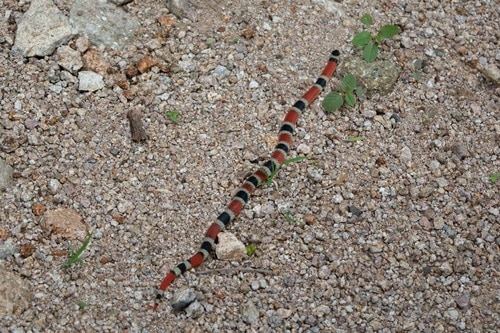
An obscure snake which has a small range in western Mexico. The filetail ground snake (Sonora aemula) lives to the west of the Sierra Madre Occidental mountain range, usually in tropical dry forests. They’re found in the following states: Chihuahua, Sonora and Sinaloa. The main coral snake they overlap with is the west Mexican coral snake (Micrurus distans), and the patterns are a close match. Both have wide red bands, followed by thinner bands in a white-black-white sequence.
This species resembles other Sonora family members (such as Mojave shovel snouts), but has rough spines along its tail, which give it the jagged “file” title. Research is severely lacking, but according to a 2008 study, their diet mainly consists of insects, particularly crickets and locusts. This makes sense given their small size of 30-50cm.
The mean size of an egg clutch was 4.6, and there was no size difference between the genders. Until 15 years ago, this species was called Procinura aemula, and many old research papers are still filed under that name.
| 9 | Scarlet snake |
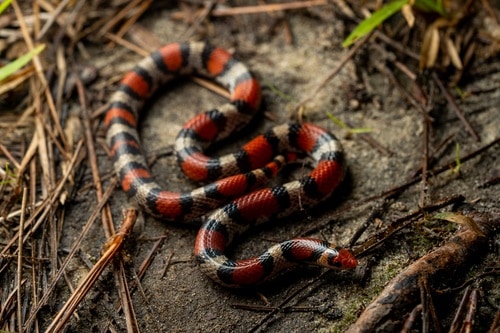
No article about coral snake mimics would be complete without the scarlet snake of Florida. This is the species which inspired the classic nursery rhyme: “red touches black, venom lack, red touches yellow, kill a fellow”, and its endless variations. In the southeastern US, this rhyme is recommended, as the resident killer is the eastern coral snake, whose bands go red-yellow-black-yellow-red-yellow and so on.
The scarlet snake, meanwhile, is a completely harmless species with no venom. They do have a severely enlarged front tooth, but this is for hacking through turtle egg shells, and licking the yolk out. Scarlet snakes are found in similar habitats to eastern coral snakes, including damp hardwood and coniferous forests, adding to the confusion. Scarlet snakes rarely bite even if picked up, preferring to release a vile serpent odour, forcing you to drop them in disgust. Cemophora coccinea inhabits all of Florida (except the keys), and occurs as far north as Philadelphia, hugging the eastern seaboard.
Some scientists believe that coral snake mimics aren’t really mimicking at all. Rather, a similar set of habitat circumstances forced the colourful bands to evolve independently, possibly involving moonlight and camouflage against fallen branches. The simple argument against this is Africa: there are no true coral snakes, and likewise, harmless snakes with red-yellow-black bands are severely lacking in Africa compared to other continents.
| 10 | Tricolour hognose snake |
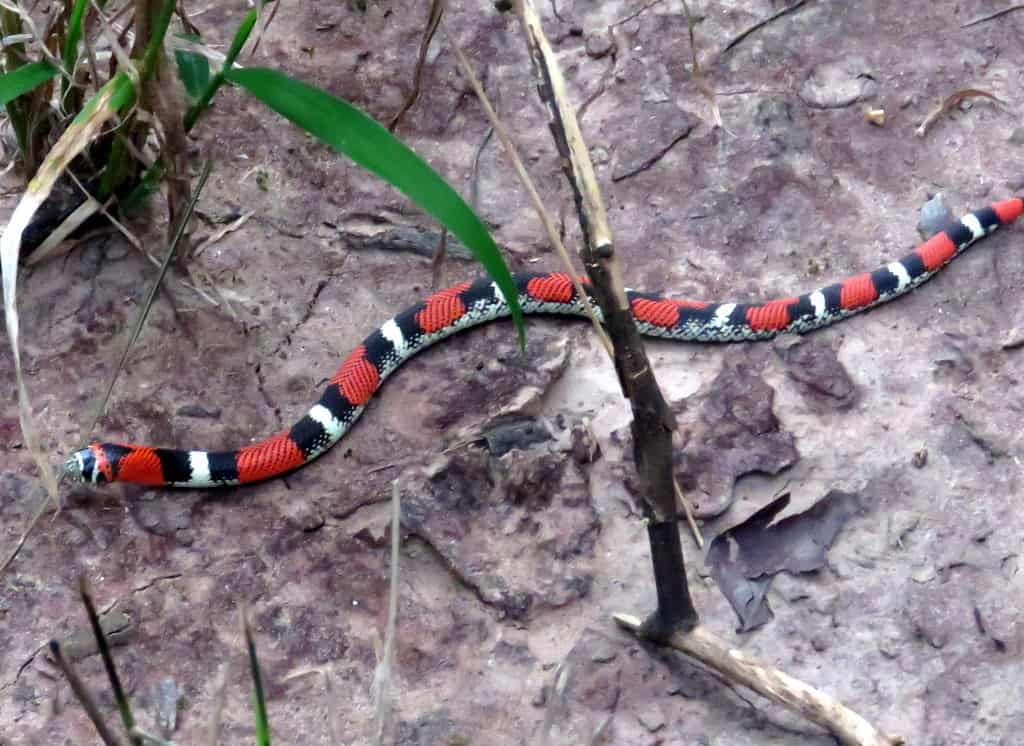
This coral snake mimic prefers open areas like grassland and sweeping cerrado savannahs, where they’re typically found close to streams. This is a slow-moving mimic which has a moderate venom of its own. Tricolour hognose snakes measure 30-60cm, and are found in an extremely tiny portion of Brazil – the extreme southwest. Most of their range lies in Bolivia, Paraguay, and northern Argentina. The main coral snake they overlap with is the Argentinian coral snake (Micrurus pyrrhocryptus), and their red, black and white bands have a close resemblance.
Zoom in close though, and there’s a feature which no coral snake of 82 in the Americas has: an upturned nose, which explains the name. This is similar in shape to the hognose snakes of the US, although the species are only distantly related. Another ID key is that coral snakes have bands fully encircling the body, whereas with Xenodon pulcher, they disappear on the belly.
Xenodon pulcher mainly eats amphibians, and is particularly abundant after heavy rains. This species was first identified in 1863, and stashed in a museum in Milan, Italy. Unfortunately, this original specimen is gone forever, as it was destroyed in 1943 during the ferocious bombardment of World War 2.
